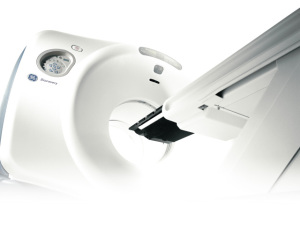PET Scans Distinguish High- and Low-Risk Uterine Tumors
by
Brendon Nafziger, DOTmed News Associate Editor | October 07, 2009

PET scans can help
tell how vicious a kind
of uterine cancer is
Molecular imaging could offer a new way to gauge the aggressiveness of a deadly cancer of the uterus, according to an article published in this month's issue of the Journal of Nuclear Medicine.
Scientists in Japan developed a technique using two fluorescent tracers, imaged with a PET scan, to tell apart the slow-acting and aggressive varieties of endometrial cancer -- tumors of the lining of the uterus, one of the most common malignant tumors in women.
The researchers, led by Testuya Tsujikawa, Ph.D., of the University of Fukui in Japan, looked at 22 women who had either known endometrial tumors or showed an early warning sign: thickening of the uterine lining.
They gave the patients both 18F-fluoroestradiol, a fluorescently tagged female hormone, and 18F-fluorodeoxyglucose, fluorescently tagged glucose.
The reasoning behind this is that low-risk tumors of the uterus tend to behave like normal tissue, and respond to estrogen, whereas high-risk, viciously malignant tumors consume huge amounts of glucose. The doctors suspected that "well-behaved" tumors would have high FES (estrogen) uptake, but low FGS (glucose) uptake, whereas the reverse would be true of nasty tumors.
And that's exactly what the doctors found when they looked at the combination of tracers through a PET scan.
The results were about 86 percent accurate, when compared against a sample later taken from a biopsy, the gold standard in endometrial cancer diagnosis.
However, the tracers are only predictive of cancer aggressiveness when used together. "Although glucose metabolism increases and ER [estrogen receptor] expression decreases during the progression of tumor aggressiveness, overlap of accumulation with a single tracer could not distinguish three groups effectively," Hidehiko Okazawa, M.D., of the University of Fukui, and a co-author of the study, tells DOTmed News by email. "The combination of two parameters like an FDG-to-FES ratio should be [a] more powerful marker for evaluation of changes in tumor phenotype."
David Mankoff, M.D., Ph.D., a professor of radiology at the University of Washington in Seattle, who's a member of the Seattle Cancer Care Alliance and who conducts similar research on breast and thyroid cancers, hails this as an important new discovery, and sees great promise in the paradigm. He thinks this technique could work on different cancers around the body, such as breast cancer, where low-risk tumors are also known to act like healthy tissue and process estrogen. Nonetheless, he's cautious about any immediate clinical applications, and doesn't think this method will directly replace biopsies.
"It's an intriguing result from the scientific standpoint," he tells DOTmed News. "I hope that, more than anything else, this study stimulates more trials."
And it is doing so, at least among Dr. Okazawa's group. They are currently working on whether this method could be useful in telling apart uterine fibroids, a painful but benign condition, from the rare malignant version, leiomyosarcoma. Last month, they also submitted a paper comparing the results from the PET scans to those from immunohistological studies.
